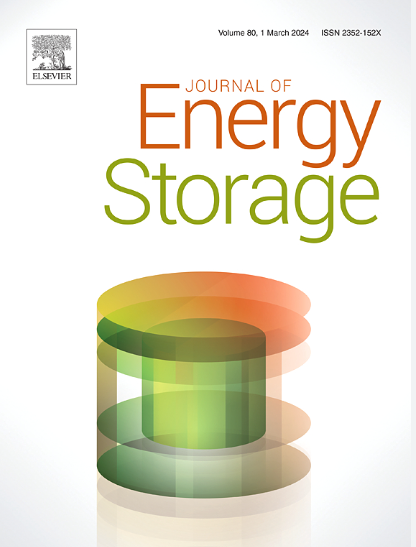Long-term optimal planning for renewable based distributed generators and plug-in electric vehicles parking lots toward higher penetration of green energy technology
IF 8.9
2区 工程技术
Q1 ENERGY & FUELS
引用次数: 0
Abstract
Due to the extensive pollution generated by conventional fuel-based power systems, there has been a significant shift in global focus toward increasing the adoption of renewable energy sources (RESs) through renewable-based distributed generation (DG), particularly wind and solar photovoltaic (PV) systems. Additionally, the electrification of the automotive sector, aimed at reducing pollution, is driving a rapid increase in electric vehicles (EVs). A critical element of this transition is the development of efficient infrastructure for plug-in electric vehicle parking lots (PEV-PLs). A collaborative planning model is essential to address the impact of integrating RESs and PEV-PLs into the electric power distribution system (DS) over the long term. This paper introduces a long-term mixed-integer non-linear (MINL) optimization planning model designed to optimize the planning and operation of RESs, including wind and PV sources, alongside PEV-PLs infrastructure. The goal is to increase the penetration of renewable energy and EVs within the DS while adhering to security constraints. The optimization model features three non-linear, incompatible objective functions: minimizing overall strategic expected investment, maintenance, emission, and operational costs; long-term power loss; and voltage deviation. Moreover, to ensure realism, the model incorporates uncertainties related to stochastic variables such as the intermittent nature of RESs, EV energy and time variables, loads, and energy price fluctuations, using Monte Carlo Simulation (MCS) and the backward reduction method (BRM). A hybrid optimization algorithm addresses the proposed objectives, combining the non-dominated sorting genetic algorithm (NSGA-II) and multi-objective particle swarm optimization (MOPSO) to minimize the three distinct objective functions concurrently. The effectiveness of the planning model is validated using the 69-bus benchmark test system, with four configurations tested: case 1 (the base case), case 2 (the base case with RESs (wind and PV)), case 3 (the base case with RESs and PEV-PLs), and case 4 (the base case with RESs, PEV-PLs, and a higher number of EVs). The impact of RESs on DS operation, PEV-PLs on RES penetration levels and DS operation, and the effect of increased EV penetration on the integrated capacity of RESs and DS operation are thoroughly investigated. Simulation results demonstrate that the optimal integration of 5 PEV-PLs, accommodating a fleet of 107 PEVs with wind and PV DGs, increases the RES penetration level from 3.35 MVA to 3.85 MVA compared to the case with RESs alone. Moreover, integrating PEV-PLs with RESs results in a 51.00 % reduction in overall operational costs, a 37.55 % reduction in overall planning and operation costs, a 52.82 % reduction in total carbon emissions, and a 45.85 % reduction in total voltage deviation.
可再生能源分布式发电机和插电式电动汽车停车场的长期优化规划,以提高绿色能源技术的普及率
由于传统燃料发电系统产生大量污染,全球关注的焦点已显著转向通过可再生分布式发电(DG),特别是风能和太阳能光伏发电(PV)系统,增加可再生能源(RES)的采用。此外,旨在减少污染的汽车行业电气化也推动了电动汽车(EV)的快速增长。这一转变的关键因素是为插电式电动汽车停车场(PEV-PLs)开发高效的基础设施。要解决将可再生能源和插电式电动汽车停车场整合到配电系统(DS)中所产生的长期影响,必须建立一个协同规划模型。本文介绍了一种长期混合整数非线性(MINL)优化规划模型,旨在优化可再生能源(包括风能和光伏)与 PEV-PLs 基础设施的规划和运行。其目标是在遵守安全约束的同时,提高可再生能源和电动汽车在 DS 中的渗透率。该优化模型具有三个非线性、互不兼容的目标函数:最小化总体战略预期投资、维护、排放和运营成本;长期电力损耗;以及电压偏差。此外,为确保现实性,该模型采用蒙特卡罗模拟(MCS)和后向还原法(BRM),纳入了与可再生能源间歇性、电动汽车能量和时间变量、负荷和能源价格波动等随机变量相关的不确定性。混合优化算法结合了非支配排序遗传算法 (NSGA-II) 和多目标粒子群优化 (MOPSO),以同时最小化三个不同的目标函数,从而实现所提出的目标。规划模型的有效性通过 69 总线基准测试系统进行了验证,测试了四种配置:情况 1(基本情况)、情况 2(含可再生能源(风能和光伏)的基本情况)、情况 3(含可再生能源和 PEV-PL 的基本情况)和情况 4(含可再生能源、PEV-PL 和更多电动汽车的基本情况)。对可再生能源对 DS 运行的影响、PEV-PL 对可再生能源渗透水平和 DS 运行的影响,以及电动汽车渗透率提高对可再生能源和 DS 运行综合能力的影响进行了深入研究。仿真结果表明,与单独使用可再生能源的情况相比,优化整合 5 个 PEV-PLs(可容纳 107 辆 PEV)以及风力和光伏 DGs,可将可再生能源渗透水平从 3.35 MVA 提高到 3.85 MVA。此外,将 PEV-PLs 与可再生能源相结合可使总体运营成本降低 51.00%,总体规划和运营成本降低 37.55%,总碳排放量降低 52.82%,总电压偏差降低 45.85%。
本文章由计算机程序翻译,如有差异,请以英文原文为准。
求助全文
约1分钟内获得全文
求助全文
来源期刊

Journal of energy storage
Energy-Renewable Energy, Sustainability and the Environment
CiteScore
11.80
自引率
24.50%
发文量
2262
审稿时长
69 days
期刊介绍:
Journal of energy storage focusses on all aspects of energy storage, in particular systems integration, electric grid integration, modelling and analysis, novel energy storage technologies, sizing and management strategies, business models for operation of storage systems and energy storage developments worldwide.
 求助内容:
求助内容: 应助结果提醒方式:
应助结果提醒方式:


